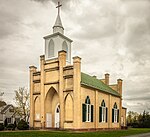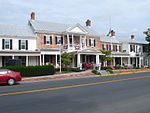The Middletown Historic District is a national historic district located in Middletown, Virginia. It originally encompassed 234 contributing properties, the majority of which are residential buildings and their associated outbuildings. The boundaries of the historic district are approximately Church Street, Senseney Avenue, and First through Sixth Streets, except for a portion of Main Street that ends just south of Reliance Road (Route 627).
The non-residential historic structures include four specialty shops, a former theater, four churches, the Town Hall, two former schools, three warehouses and an inn. Notable buildings include the former Middletown Mission Church (c. 1818), Grace United Methodist Church (1897), the former Mt. Zion Church (1880), the former Middletown School (1909), the Town Hall (1880), the Wayside Inn (1797), Larrick's Tavern (1750), the former Wayside Theatre (1946), and Lafolette House (1800). Located in the district and separately listed on the National Register of Historic Places (NRHP) and Virginia Landmarks Register (VLR) is St. Thomas Chapel (1837).
The area that is present-day Middletown began developing in the mid-18th century due to the Great Wagon Road that brought settlers and commerce to the Shenandoah Valley. When the Virginia General Assembly formally established Middletown in 1796, there were already many residential and commercial buildings in the area. The town continued to develop thanks to the Valley Turnpike, present-day Main Street/U.S. Route 11, which connected the town to nearby Newtown (Stephens City) and Strasburg.
During the 19th century Middletown experienced continued residential and commercial growth until the Civil War. Many skirmishes took place in the area during Jackson's Valley campaign. The 1864 Battle of Cedar Creek, which began just south of the town limits before moving north through the town, resulted in many damaged properties. Commerce increased after a railroad track built in 1870 helped the town recover from the war's effects. Many of the town's historic houses were constructed in the late-19th century.
In the 20th century Route 11 was widened, utilities were installed, and the county's first high school opened in Middletown. Additional houses, warehouses, and commercial buildings, including a bank and movie theater, were constructed. A fire station built in the 1960s replaced historic houses, a trend that continued during the next few decades.
Due to the efforts of a local heritage group and with support from residents, a large portion of the town was listed as a historic district by the VLR and NRHP in 2003. Despite the historic designation, there have been several contributing properties demolished. Town officials are hoping to avoid further demolition by encouraging residents to maintain their property and by preventing the construction of buildings that do not fit in with the character of the historic district.







